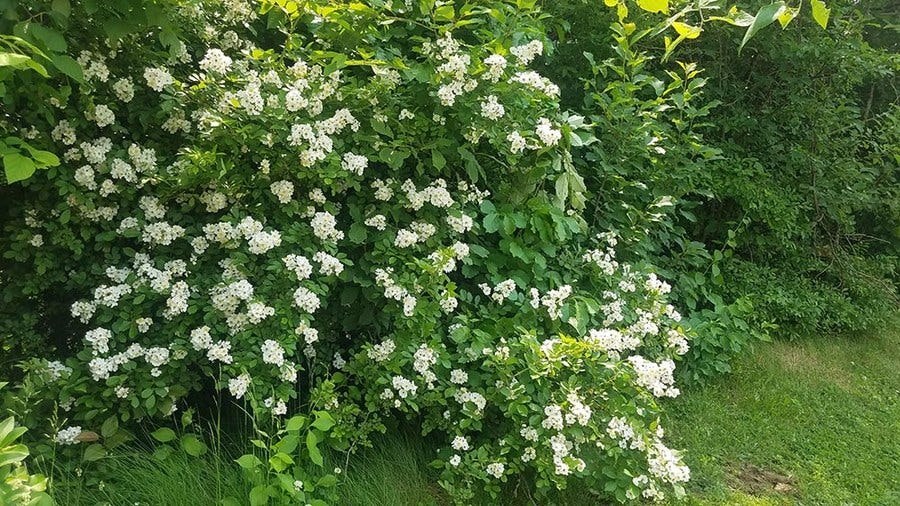Posted: January 19, 2023
The PA iMapInvasives Program has proposed a New Year's challenge to all natural resource professionals, teachers, students, and community scientists interested in invasive species. To this, I would add home gardeners! They suggest we set ourselves up to learn about invasive species one month at a time, one species per month, through the 2023 calendar year.

Multiflora rose hedge at the forest edge. Photo credit: Skylure Templeton and Dave Jackson, Penn State
If you're anything like me, you know you have invasive species in your landscape, but you feel overwhelmed by the challenging and sometimes confusing information you receive on what to do about them. Sometimes breaking a problem down into smaller parts helps with solving it.
The iMapInvasive group suggests we set ourselves up with a schedule in advance - learning about a different species each month. And they offer a series of questions to help us do an excellent job with this task, as follows:
- How do I identify this species; what are its distinguishing characteristics?
- What are some of its look-alikes?
- What type of habitat(s) does it prefer?
- Where is it native?
- Where has it been found to date in PA and the Mid-Atlantic region?
Ahh. Where do I begin? Recently, I learned that it's possible to apply controls to some invasive species, including multiflora rose (Rosa multiflora), during the dormant season. During dormancy, it is easier to access the plants and less likely to harm neighboring plants and beneficial insects. I like this idea. Temperatures will be cooler, and I will have more time to allot to this task. With that in mind, I've chosen multiflora rose as my January invasive plant of the month.
There are plenty of multiflora rose, recognized as a PA Noxious Weed, in my woodlot, which probably arrived many years ago when the woods were disturbed by timbering. It's easy for me to recognize. My notes on this plant are as follows:
- Multiflora rose is a dense, thorny shrub with arching canes/stems capable of rambling up trees. Its leaves are pinnately compound, divided into seven to nine leaflets, and finely serrated.
- Multiflora rose can easily be confused with other rose species, both native and non-native, especially when not in bloom. This is a concern since some native species are of conservation interest. One way to identify a multiflora is to look at the stipules, which are conspicuously fringed, whereas they are not fringed on a PA native rose species. (This requires some studying of photographs to understand this identifier.)
- Multiflora rose has a wide tolerance for various soil, moisture, and light conditions. It can be found in dense woods, along stream banks and roadsides, and in open fields and prairies.
- Multiflora rose is native to Asia.
- It now occurs throughout most of the United States, especially the eastern half.
With the information in hand, I am ready to form a plan to control this invader in my woodlot. Using Integrated Pest Management (IPM) as my guide, I first considered cultural and mechanical control methods. But since I can't get to it easily to use frequent cutting or mowing for two to four years, this is not a good option. Complete removal by pulling is not feasible since all root material must be removed to prevent re-sprouting. And this stuff is thorny!!
I learned that biological controls are currently under investigation - a native viral pathogen and a seed-infesting wasp - however, both measures have the potential to impact native rose species, eliminating these as possible controls.
Lastly, I must consider chemical control. Applying glyphosate or triclopyr on freshly cut stems is an effective control method since it destroys the root system and prevents re-sprouting. And I know this is effective during the dormant period, which reduces the likelihood of damaging desirable species or harming beneficial insects.
I will be watching the weather forecast for this month (and the next) to schedule myself to work on cutting and treating multiflora rose while the conditions are suitable.
For more information on the iMapInvasives Challenge, refer to this article by Amy Jewitt, Invasive Species Coordinator at the Western Pennsylvania Conservancy: Hiding in Plain Sight.
Resources
DCNR Multiflora Rose Fact Sheet
Penn State Extension Multiflora Rose Fact Sheet
By Deb Christopher, Penn State Master Gardener

